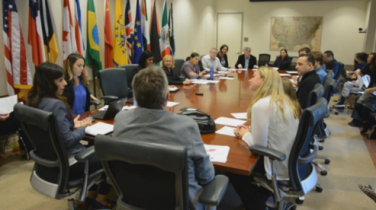FDA Efforts to Bring Patients into Treatment Decisions Focus of NORD Webinar

The U.S. Food and Drug Administration (FDA), a vast government bureaucracy, employs about 17,500 people and had a budget of $5.7 billion in 2019. Yet even with its enormous resources, the FDA these days relies more and more on patients to provide feedback on therapy development, set regulatory priorities, and contribute to patient-reported outcomes.
Starting with an HIV/AIDS patient group in the late ’80s, further expanding into oncology and other life-threatening health issues in the ’90s — and most recently on rare disease — the agency has given patients an ever-growing role in its regulatory framework.

Attendees listen to a presentation at a PFDD meeting. (Photos courtesy of NORD)
In a webinar organized by the National Organization for Rare Disorders (NORD), FDA representatives showed patients how to directly steer the treatment approval pipeline in a way that best serves their interests.
The Jan. 23 NORD webinar featured several FDA officials: Andrea Furia-Helms, director of patient affairs staff; Michelle Tarver, director of patient science and engagement at the Center for Devices and Radiological Health; Robyn Bent, director of patient-focused drug development (PFDD); and Diane Maloney, associate director for policy at the Center for Biologics Evaluation and Research (CBER).
Bent’s department at the FDA, the Center for Drug Evaluation and Research, deals with PFDD meetings, led both internally and externally, to advance patient engagement.
Having previously worked with patients and families for 20 years as a pediatric nurse, Bent understands many of the priorities these people have. But she was proven wrong early during an externally led PFDD meeting on a rare disease known as CDKL5 deficiency disorder (once classified as an atypical form of Rett syndrome), whose earliest symptoms are seizures and developmental delays.
Bent had predicted most parents would be concerned with treating seizures. Yet one mother of a girl with CDKL5 told her that treating constipation was a bigger priority, because of the distress and discomfort it caused her daughter.
FDA encourages patient views
The FDA offers plenty of other initiatives through its Patient Affairs office, including the Patient Engagement Collaborative and various rare disease listening sessions, in collaboration with NORD. The agency established Patient Affairs in 2017 to help patients contact the FDA.
The Patient Engagement Collaborative links patient organizations with individual representatives to discuss patient engagement in medical product development. In turn, listening sessions educate patients about the FDA, and inform decision-making and early research and development at the regulatory body.
“There’s a growing understanding from all of us that patients and their caregivers have very important voices and have an impact — not only in figuring out what the right endpoints are but also throughout the entire process,” Bent said.
Tarver discussed similar listening programs at the Center for Devices and Radiological Health, which further connects patients with the agency. These programs include group conversations, community town halls, and the Patient Engagement Advisory Committee (PEAC), which consists of patients, caregivers and advocates who meet annually to offer their perspectives on emerging medical devices.

Attendees at an FDA Rare Listening session.
Since 2017, the PEAC has created a framework for engagement in clinical trials, supporting data sharing, and instituting better communication in cybersecurity safety.
Maloney introduced the various patient engagement programs at CBER, which regulates biologic products such as blood, human tissue, gene therapies, and vaccines.
CBER has a three-pronged approach when it comes to patient engagement. The Patient Engagement Workshop conducts internal information-sharing and brainstorming sessions across the agency, while the Rare Disease Coordinating Committee advances products for people with rare diseases, and the Science of Patient Input Initiative obtains patient input to support product regulation.
Patients interested in further involvement can apply to be an FDA Patient Representative as a special government employee. In that role, the patient becomes a consultant for the FDA’s decision-making process.
Furia-Helms encouraged patients to get involved in treatment development as early and as often as possible. Bent also favors organizations getting the FDA involved a year before a proposed and externally led PFDD, and Maloney told viewers it’s important to involve as many players as possible to get an accurate diagnosis.
Patients can contact the FDA to set up a meeting through the Patient Affairs office, which is in close communication with each of the organizations involved in this webinar, by filling out a Request to Connect form.







